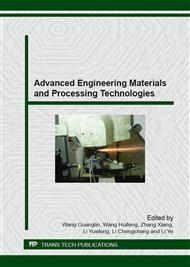p.213
p.218
p.224
p.231
p.237
p.244
p.250
p.259
p.267
Finite Element Analysis of High Temperature Alloy Cutting Process Based on Abaqus
Abstract:
The nickel-based superalloy GH4169 is widely used in the aerospace industry because of its excellent comprehensive mechanical properties under high temperature and corrosion condition. It is one of the most difficult-to-machine materials due to low thermal conductivity and hard particle. One method of solving the problem of maching difficult-to machine materials is using new material cutting tool. PCBN tool has excellent cutting property in maching nickel-based superalloy because of its great hardness, high wear resistance and good chemical stability. The cutting process of in-depth study of PCBN tool cutting nickel-based superalloy, shows the variation rule of cutting force and cutting temperature, can provide a theoretical basis for process specification high temperature alloy and efficient processing, has a very big practical significance. On the basis of reasonable hypothesis, this paper discusses in detail the transformation from actual turning to 2D orthogonal free cutting geometry model. Based on this,through the establishment of simulation model of PCBN turning the nickel-based superalloy GH4169, studying on the tool rake angle γo, back angle αo, cutting speed vc and feed f on cutting process of cutting force and cutting temperature effect.
Info:
Periodical:
Pages:
237-243
Citation:
Online since:
October 2015
Authors:
Price:
Сopyright:
© 2016 Trans Tech Publications Ltd. All Rights Reserved
Share:
Citation:


